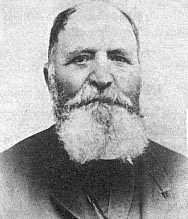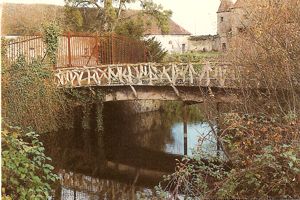Joseph Monier facts for kids
Joseph Monier (born November 8, 1823, in Saint-Quentin-la-Poterie, France – died March 13, 1906, in Paris) was a French gardener. He was one of the main inventors of reinforced concrete. This special type of concrete is much stronger than regular concrete.
Contents
What is Reinforced Concrete?
Joseph Monier was a gardener. He found that the flowerpots he used were not strong enough. Clay pots broke easily. Wooden pots wore out quickly and plant roots could break them.
Monier started making pots and tubs from concrete. But these were still not strong enough. To make them stronger, he tried putting iron mesh inside the concrete. This made the pots much more stable.
He wasn't the first person to try this idea. But he saw how useful reinforced concrete could be. He worked hard to share his invention with others.
Monier's Inventions and Patents
Monier showed his invention at the Paris Exhibition of 1867. On July 16, 1867, he received his first patent. This patent was for iron-reinforced troughs used in gardening.
He kept finding new ways to use this strong material. He got more patents for:
- Iron-reinforced concrete pipes and basins (1868)
- Iron-reinforced concrete panels for building walls (1869)
- Bridges made of iron-reinforced concrete (1873)
- Reinforced concrete beams (1878)
In 1875, the first bridge ever built using iron-reinforced concrete was made. Monier designed this bridge at the Castle of Chazelet.
Why Reinforced Concrete Works
Monier's big idea was to combine steel and concrete. This way, each material's best qualities were used.
- Concrete is easy to get and shape. It is very strong when pushed or crushed (compressive strength). But it is weak when pulled apart (tensile strength).
- Steel is also easy to get, often in long bars. It is extremely strong. But it's hard and costly to shape into custom forms.
Before Monier, people avoided using concrete for thin walls or beams. This was because it would break when pulled. But if you add a network of small steel rods to the bottom of a concrete slab, it becomes much stronger. The steel handles the pulling forces, and the concrete handles the pushing forces.
Others Who Used Monier's Idea
François Hennébique saw Monier's reinforced concrete tubs at the Paris Exhibition. He started trying to use this new material for buildings. He started his own company and, in 1892, patented a full building system using reinforced concrete.
In 1885, a German engineer named Gustav Adolf Wayss (1851–1917) bought Monier's patent. He did more research on using reinforced concrete for building. He also started several construction companies that used reinforced concrete.
Monier's Life and Work
Joseph Monier was born in a small town called Saint-Quentin-la-Poterie. He was one of ten children in a family of gardeners. Because everyone was needed to work, Joseph did not go to school.
By age 17, he was a skilled gardener. He got a job at a mansion in Paris. There, he took evening classes and learned to read and write. He met important people who helped him later in life.
Working at Tuileries Gardens
In 1846, Monier started working at the Tuileries Gardens in Paris. He was in charge of the orange trees. These trees were moved indoors during winter. He needed stronger pots for them.
He began making pots from cement mixed with other materials. He reinforced them with a grid of iron rods. At that time, many thought that iron inside concrete would cause it to crack. Monier spent years proving that his method worked.
Expanding His Business
Monier realized his strong containers could also store water for gardens. He continued his education in gardening and landscape design. In 1849, he opened a small workshop while still working at the Tuileries. He started taking on landscaping projects.
He made artificial rocks and caves for large gardens using his "ferro-cement" (iron-cement). He also built small garden houses. He shaped the concrete to look like rustic wooden buildings.
In July 1867, he showed his ideas at the Paris International Exhibition. Soon after, he got his first patent for containers. He then got more patents for pipes and pools. His projects included a large water tank and a terrace roof. By 1869, his business had offices, workshops, and greenhouses.
Challenges and Successes
In 1870, Monier faced a big challenge. There was a war, and Paris was under siege. People were starving and took everything from his property, including his horses. His caretaker died trying to stop them. Then, bombs ruined what was left. Monier and his family struggled through a very hard winter.
Even after the war, Paris faced more problems. But Monier and his workers slowly rebuilt the business. As life returned to normal, his business grew. His reputation spread by word of mouth. He built many water tanks, some very large. One tank at Bougival (1872) held 130 cubic meters of water.
Monier always checked with his clients years later. He wanted to make sure his products were still working well. He also asked for their good reviews. Many important people were his customers.
Bridges and Other Innovations
In 1873, Monier applied for a patent to cover bridges. In 1875, he built his first bridge for a client. It was 14 meters long and crossed a castle moat. The bridge had strong beams and guard rails that looked like wood. This style is called faux bois (French for "false wood").
Around 1875, Monier built a staircase for his workshop. He also applied for a patent for this type of construction. Another patent in 1878 was for reinforced concrete railway sleepers. This patent clearly stated that the cement protected the iron from rusting.
Later Life and Legacy
In 1886, Monier received a patent for a system to build houses. He built a demonstration house to show how strong it was. He said it could resist earthquakes, ice, heat, and fire. He got a job to build such a house in Nice.
Sadly, in 1887, his second son, Paul, died after falling from scaffolding on this project. Monier's oldest son, Pierre, had already left the family business. This left Joseph without sons to help him.
In 1888, Monier's company went bankrupt. But in 1890, he started a new company. In 1891, he got another patent for pipes to hold telephone and electricity cables.
Monier's last known project was a water reservoir for an Old People's Home in Clamart. It was a large, round structure, 10 meters high. The reservoir is still standing today (as of 2010).
After this, Joseph Monier mostly retired. He faced financial problems from taxes and debts. Many foreign companies that had made money from his patents helped him. They asked the French President to give him a pension. They also collected money for him. Monier thanked them in a letter published in 1902.
Joseph Monier died on March 13, 1906. He was buried in Billancourt. His work changed how buildings and structures are made around the world.
Monier's Patents Around the World
Monier took out patents in many countries in Europe and beyond. He often sold the rights to his patents outside France to local business people and engineers.
His name became well-known because of Gustav Adolf Wayss. Wayss bought Monier's patents in Germany and Austria. He promoted the technique as "Das System Monier" or "Monierbau." Scientists and engineers quickly learned more about reinforced concrete structures.
Monier's Name in Australia
Starting in the 1890s, Monier's patents were used in Australia. The main products were pipes and arch structures. The White's Creek and Johnston's Creek Aqueducts, built in 1897/98, were the first reinforced arch structures in Australia.
Monier pipes were also used as foundations for bridges. Joseph Monier's name lived on in companies like the Monier Pipe Company of Melbourne. An important engineer for these companies was John Monash. About 20 Monier arch bridges were built in Victoria, Australia.
See also
 In Spanish: Joseph Monier para niños
In Spanish: Joseph Monier para niños




